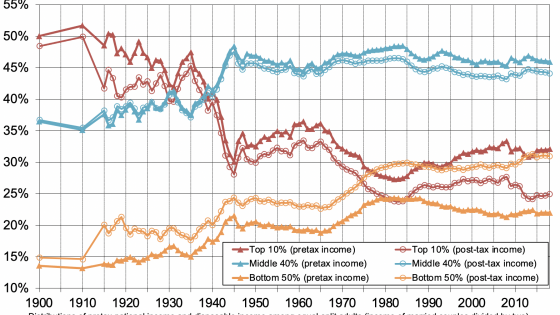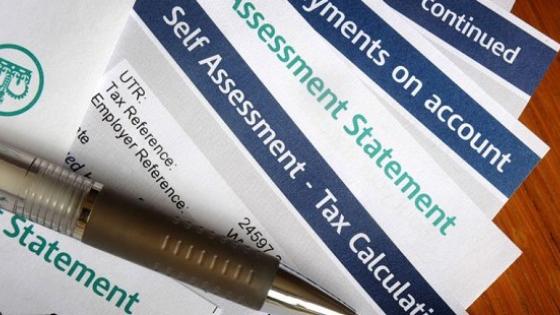The term pre-distribution was popularised a decade ago by then Labour Party leader Ed Miliband (BBC 2012). He was influenced by the writings of academic Jacob Hacker (2011). It was advanced in self-conscious contrast to redistribution. Redistribution is the application of tax and transfer schemes to reduce the inequality of market incomes. Pre-distribution seeks to obtain a less unequal distribution of market incomes in the first place, so that redistribution after the event is not necessary. To quote Miliband: "Think about somebody working in a call centre, a supermarket, or in an old peoples' home. Redistribution offers a top-up to their wages. Pre-distribution seeks to go further - higher skills with higher wages." In line with this general argument, the recent work of Piketty et. al. (2022) argues that “policy discussions on inequality should pay more attention to policies affecting pre-tax inequality and should not focus exclusively on redistribution.”
The rhetorical advantages of pre-distribution are manyfold. It shifts attention away from the class war connotations of high marginal tax rates on the rich, and it ties into a politically attractive discourse on equality of opportunity rather than equality of outcomes. Thus, an often-heard refrain in policy debates is that rather than using progressive taxation to reduce inequality of incomes, the government should use equal public provision of education to reduce inequality of education, and then let the distribution of income be whatever it turns out to be based on individual effort. Reducing inequality of education is pre-distribution. High taxation of high incomes is redistribution. On this argument, not only does redistribution create inefficiencies because of the disincentive effects of taxation, but equalising opportunity through pre-distribution is morally superior to equalising outcomes through redistribution because outcomes depend on individual effort.
Despite the seeming attractiveness of pre-distribution, our recent research has argued that the distinction between pre-distribution and redistribution is not all clear cut (Haaparanta et. al. 2022). Pre-distribution requires redistribution, and redistribution aids pre-distribution. An intuitive account of this entanglement can be provided as follows. Consider a society where educational achievements, incorporating quality as well as quantity, depend both on public provision of education and on parental inputs. Inequality of educational achievements, and the inequality of incomes that follows from it, then depends on inequality of both public and private inputs to education. Equalising public inputs, pre-distribution, is a start but it is only one component. Even with equal provision of public education, inequality in parental inputs will leave the pre-distribution unequal. And reducing inequality in parental inputs requires reducing inequality in parental incomes, in other words, redistribution. The flip side of this is of course that redistribution of market incomes does not just reduce inequality of these incomes, it also reduces inequality of parental inputs to education and thus inequality of education. In other words, redistribution enhances pre-distribution.
Furthermore, even if there is no impact of parental inputs on children’s educational achievements, the provision of public education is not a free good. It requires resources, which will have to be raised by taxation. The taxation regime and its degree of progressivity will have to be debated and decided. Thus, pre-distribution does not in any way eliminate the question of redistribution. The provision of public education and raising the resources to pay for it are closely intertwined.
Our formal analysis is based on the classic Nobel prize winning contribution of Mirrlees (1971). We consider an unequal society in which parents spend some of their earned incomes on the education of their children, and this parental input together with equal provision of public education leads to the educational outcomes for children. The government has at its disposal instruments of taxation as well as the level of public provision of education, subject to an overall budget constraint. How should the government choose these instruments in such a setting? The answer depends of course on the government’s objectives. Since the earning of higher incomes requires the use of higher labour effort, the appropriate measure of parental wellbeing is not income per se but utility. One strand of the literature takes as the government’s objective a social welfare function defined on the distribution of utilities, which in turn are the outcomes of optimal parental choices on labour, leisure, and expenditure on inputs for children’s education. This will be recognised as the classic ‘welfarist’ formulation of the problem following Mirrlees (1971) – welfarist because the government’s objective function depends on, and only on, the ‘utility outcomes’ (of parents in this case).
We contrast this with a ‘non-welfarist’ formulation in which the government cares about, and only about, the distribution of educational outcomes, since this is the distribution of income earning opportunity for the next generation. Parental utility functions do not matter directly in the government’s objective function and thus neither do inequalities of utilities or incomes. This follows the arguments of Roemer (1998), who draws on a philosophical tradition going back to Rawls (1971), Dworkin (1981), and Sen (1985), and distinguishes between ‘circumstances’ (factors outside the control of the individual) and ‘effort’ (factors within the individual’s control). In this view, inequalities attributable to circumstances are the only legitimate target for government intervention.
Is it then the case that progressive taxation is not used at all under opportunities-based objectives? The answer is no. In accordance with the simple intuition developed above, our formal results show that the argument of “progressive taxation for welfarist objectives and equal provision of public education for equality of opportunity objectives” poses a false dichotomy. When the government cares about the inequality of outcomes (utilities), it uses both equal provision of education and progressive taxation. But even when it cares only about the inequality of educational achievements, in other words when it only cares about pre-distribution and inequality of opportunity, its optimal strategy is to also use progressive taxation alongside equal provision of public education. Progressive taxation is a potent instrument for equalising opportunity through equalising education outcomes. In other words, pre-distribution requires redistribution.
Further, we ask the question: what does the differential use of progressive taxation under the two objectives depend upon? We derive and present optimal tax formulae in a way that facilitates comparison between the two regimes. When educational outcomes are highly sensitive to parental inputs relative to public provision, perhaps paradoxically the case for progressive taxation tends to be stronger under the equality of opportunity objective. Redistribution is a potent instrument for pre-distribution.
Our results are also consistent in spirit with those of Roemer and Unveren (2016), who set up an intergenerational model in which the current generation makes decisions on education for their children, the future generation. They use public provision of education as the tool to equalise opportunities. The taxes, however, are not used for redistribution but only to finance the public provision of education. Their numerical simulations show that when private acquisition of education is possible, it can undo the intended effect of state provision.
Equality of opportunity has emerged as a major framework in the public policy discourse. Relatedly, pre-distribution has gained traction as a potential focus of policy, often in contrast to redistribution. Our research shows that progressive taxation and redistribution on the one hand, and pre-distribution and equality of opportunity on the other, are not opposed to each other. One urgent task in future research would be to make considerable progress in the evaluation of the quantitative importance of the results and comparisons about the extent of progressivity under different social welfare goals. Such progress would also require new empirical evidence on how private educational investments depend on tax rates and on publicly provided education, and on how public and private inputs go together to produce overall educational outcomes.
References
BBC (2012), “Ed Miliband unveils 'predistribution' plan to fix economy”, 6 September.
Dworkin, R (1981), “What is equality? Part 2: Equality of resources”, Philosophy and Public Policy 4(10): 283–345.
Haaparanta, P, R Kanbur, T Paukkeri, J Pirttila and M Tuomala (2022), “Promoting Education Under Distortionary Taxation: Equality of Opportunity Versus Welfarism”, Journal of Economic Inequality 20: 281–297.
Hacker, J (2011), “The institutional foundations of middle-class democracy”, Policy Network, 6 May.
Mirrlees, J A (1971), “An exploration in the theory of optimum income taxation”, Review of Economic Studies 38(114): 175–208.
Piketty, T, M Guillot, B Garbinti, J Goupille-Lebret and A Bozio (2022), “Pre-distribution versus redistribution: Evidence from France and the US”, VoxEU.org, 18 November.
Rawls, J (1971), A Theory of Justice, Cambridge: Harvard University Press.
Roemer, J E (1998), Equality of Opportunity, Harvard University Press.
Roemer, J E and B Unveren (2016), “Dynamic equality of opportunity”, Economica 84(334): 322–43.
Sen, A (1985), Commodities and Capabilities, Elsevier, Amsterdam.








